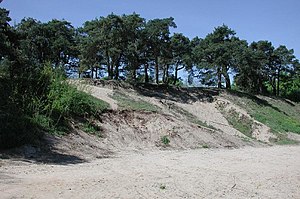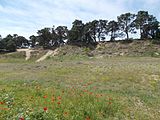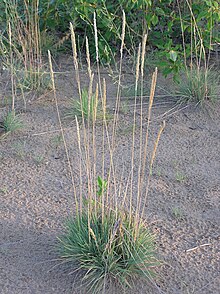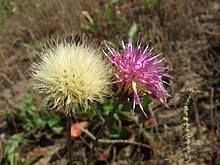Sandhausen dunes
|
Sandhausen dunes horse drive
|
||
|
Sandhausen dunes, part of the horse drive south |
||
| location | Southern outskirts of Sandhausen near Heidelberg , Rhein-Neckar-Kreis , Baden-Württemberg , Germany | |
| surface | 15.7 ha | |
| Identifier | 2,237 | |
| WDPA ID | 555588633 | |
| Geographical location | 49 ° 20 ' N , 8 ° 39' E | |
|
|
||
| Setup date | 1929 | |
|
Sandhausener dune, care Schönau-Galgenbuckel
|
|
| location | North-western outskirts of Sandhausen near Heidelberg |
| surface | 21.4 ha |
| Identifier | 2,238 |
| WDPA ID | 555588634 |
| Geographical location | 49 ° 21 ' N , 8 ° 38' E |
| Setup date | 1950 |
The Sandhausener Dunes (or Sandhausener Dunes ) are two nature reserves with a total area of around 37 hectares in the area of the municipality of Sandhausen in the Rhein-Neckar district : the NSG Sandhausener Dünen Pferdstrieb and the NSG Sandhausener Düne, Pflege Schönau-Galgenbuckel . These are inland dunes , as they are widespread in the northern Upper Rhine Plain. They are characterized by flora and fauna that are seldom found in Germany: plants and animals that are specially adapted to heat, water shortages and poor nutrients, which are usually found in the steppes of Eastern Europe or in the Mediterranean region. These include the mountain stone herb , the rare and therefore protected sand silverside in Europe and insects such as the wasp or the milkweed hawk .
meaning
The Sandhausen dunes are among the most remarkable dune areas in Baden-Württemberg, as they have a vegetation that has become rare in this state and that only thrives on calcareous, humus-poor sand grass. Open sand corridors were widespread in the Upper Rhine area in the Middle Ages with its extensive agriculture (fallow land , forest pastures). Afforestation, intensive asparagus cultivation, development and industry have pushed these sandy areas far back. Plants typical of sand dunes, such as straw flower , blue-green Schillergras and sand silvershirt, were still to be found around 100 years ago in the entire area between Friedrichsfeld - Rheinau and Walldorf - Hockenheim . Their occurrence is now limited to a few areas such as the nature reserves in Sandhausen.
Origin and history
The dunes were formed as sand deposits from the Rhine towards the end of the last Ice Age . The large sandbanks on the edge of the river were transported by wind; in some places this sand piled up to form inland dunes. Based on measurements using the radiocarbon method, the age of the sand dunes is estimated to be around 10,000-15,000 years. The Sandhausen dunes consist of fine material that was blown out of the Ice Age Rhine floodplains and accumulated on elevated areas. In the post-ice age, the now forested dunes initially remained untouched. It was not until the High Middle Ages that the dunes were at least partially cut down so that they could be used for agriculture.
The intensive use of the dunes as pasture forest caused severe destruction, which was attempted to be countered in the 18th century with reforestation with pine trees. However, the pine forests were later converted back into arable land. The sub-area “Pflege Schönau-Galgenbuckel” was also used as a military training area at times. All of this caused erosion and destruction of the sward, so that the typical soil of the Sandhausen dunes with its partly calcareous and partly decalcified sand was created. Plants native to southern and southeastern Europe settled on the open limestone sand surfaces, and found ideal living conditions for them in the sand dunes.
Characteristics
A characteristic part of the two areas is the sand dune wall that runs from northwest to southeast in the Rhine plain and is typical of the northern Upper Rhine plain.
The nature reserve Sandhausener Dünen Pferdstrieb , located on the southeastern edge of the village, bears the name of the horse drift dune located there. It was used as horse pasture, but dead cattle were also buried there. The area was placed under nature protection in 1929, it is divided into two parts by the Am Forst road : Pferdstrieb north and south. The northern part is now enclosed on three sides by residential areas due to the ongoing development. The area of the nature reserve covers 15.7 hectares, the reserve number is 2.237. ( ⊙ )
The nature reserve Sandhausener Düne, Pflege Schönau-Galgenbuckel , north-west of Sandhausen, borders in a north-easterly direction on arable land, otherwise on wooded areas. Only on a short section in the east is it touched by a recently built residential area. In 1950 it was placed under nature protection, in 1979 a wooded area was added and designated as a combined landscape and nature reserve. The area covers 21.4 hectares, the protected area number is 2.238. ( ⊙ ) The name refers to the care Schönau as well as the Gewann Galgenbuckel , probably named after a former wolf gallows , on which wolves were hung as a deterrent. The fact that the area is free of forests in its core area is due to its former use as a military training area.
The Federal Agency for Nature Conservation manages both areas with a total area of 37.2 hectares and assigns them to IUCN Category IV, which stands for biotope and species protection areas. Both nature reserves are (along with other areas) sub-areas of the FFH area "sand areas between Mannheim and Sandhausen".
Plant life and vegetation
The plants on the dunes of Sandhausen are specialists who have adapted to the extreme conditions on the dunes: heat, drought and nutrient deficiency. These include drought-loving plants that are otherwise only found in the steppes of Eastern Europe or in the Mediterranean area:
Steppe plants
- Blue-green Schillergrass ( Koeleria glauca )
- Sand straw flower
- Sand stone herb
- Ruthenian brine
- Sand-silver notch
- Steppe Spurge
Mediterranean plants
Other rare specialists on the dunes
Forests border directly on the dunes, some of which are also part of the nature reserve and serve as transition and buffer zones. There you can find loose pine stands next to oaks and beeches as well as the non-native locust, which is spreading ever further .
In terms of plant sociology, the sandy lawns on non-decalcified dune sand in the nature reserve form the association Jurineo (cyanoidis) -Koelerietum-glaucae (alternatively also: Festuco-Koelerietum glaucae), the blue-bush grass lawn. This was scientifically described for the first time using the sandy areas around Sandhausen and Schwetzingen. This vegetation unit is located here, like its character species (such as the eponymous silberscharte , Jurinea cyanoides ), on the extreme western edge of its distribution. Still widespread in the Upper Rhine Plain north of Hockenheim and Walldorf in the 19th century, the nature reserve is the last remaining stock in Baden-Württemberg, and only a few relics have remained in the neighboring Hesse. The NSG is the most important place of growth in the state of Baden-Württemberg for the distinctive species of mountain stone herb , sand silver wedge , blue-green schillergrass ( Koeleria glauca ), cone-fruited limeweed and sand thyme . The pine forest of the plant community of the Peucedano pinetum or Haarstrang pine forest, which is widespread in the area, is also rare in Germany; only a few, fragmentary stocks in the northern Upper Rhine plain have survived.
Wildlife
In the animal world of the Sandhausen dunes, the insects are of particular interest - the dunes are an ideal biotope for ant lions, wild bees and digger wasps. Examples of typical inhabitants of the dunes are the gyroscopic wasp , the blue-winged wasteland insect , the milkweed hawk and the dune tiger beetle . In addition to insects, the most species-rich group of animals, vertebrates can also be found on the dunes: mice, hedgehogs and martens use the dunes to forage. Typical bird species in the two nature reserves are, for example, the woodlark , the hoopoe and the goat milker .
You can even find snails on the dunes: the white heather snail is often seen on plant stalks in midsummer, where it escapes the summer heat on the sand.
Protective and care measures
In order to preserve the Sandhausen dunes with their special flora and fauna, various measures have been taken in the nature reserve. Since many of the plants rely on open, unforested sand dunes, trees were felled or areas mowed. Bushing of the sandy lawn in the horse drive is prevented by regular "dune cleaning" by students and teachers from the Sandhausen high school. The northern part of the horse drive was fenced in to prevent visitors from trampling on rare plants. In the southern part of the horse drive and in the sub-area “Pflege Schönau-Galgenbuckel” wooden barriers and fences were erected to direct visitors so that they do not leave the marked paths as much as possible.
See also
literature
- District Office for Nature Conservation and Landscape Management Karlsruhe: Nature conservation areas Sandhausen dunes and Zugmantel-Bandholz (leaflet). bec.media, Karlsruhe 2003.
- Peter René Bitschene, Manfred Löscher: The sand houses space in geological time . In: Home book of the community Sandhausen . Heidelberger Verlagsanstalt, Sandhausen 1986, pp. 9-21.
- Municipality of Sandhausen / Ministry of Food, Agriculture, Environment and Forests / District Office for Nature Conservation and Landscape Management Karlsruhe: The nature reserves Sandhausen: Dune nature reserves (leaflet). Heinz W. Holler offset printing, Karlsruhe 1986.
- State Institute for Environmental Protection Baden-Württemberg / District Office for Nature Conservation and Landscape Management Karlsruhe (Ed.): The Sandhausener Dunes: Natural history contributions to the nature reserves "Horse Drive" and "Care Schönau-Galgenbuckel" , compiled by Ulrike Rohde. BNL, Karlsruhe 1994, ISBN 3-88251-214-8 .
- Wulfard Winterhoff: The flora of the sand houses dunes . In: Home book of the community Sandhausen . Heidelberger Verlagsanstalt, Sandhausen 1986, pp. 23-30.
- L. Zimmermann: The forest around Sandhausen . Schimper, Schwetzingen 1975.
Web links
- Baden-Württemberg Ministry for the Environment, Climate and Energy: NSG Sandhausener Dünen (accessed on October 1, 2014)
- Ministry for the Environment, Climate Protection and the Energy Sector Baden-Württemberg: Environment Theme Park (accessed October 1, 2014)
- Peter Weiser: The inland dune in Sandhausen (accessed on May 17, 2016)
- Verena Haunss: The Sandhausen dunes near Heidelberg. Nature reserve horse drive and care Schönau-Galgenbuckel , student thesis at the FH Bingen, STG environmental protection, WS 2001/2002. Memento from April 16, 2016 in the Internet Archive .
- Nature conservation center: local & regional & supraregional , especially Sandhausen / Baden - dunes, dry grass and a wet biotope. Memento from March 14, 2016 in the Internet Archive.
Individual evidence
- ↑ a b c d District Office for Nature Conservation and Landscape Management Karlsruhe: Nature reserves Sandhausener Dünen and Zugmantel-Bandholz (leaflet). 2003, p. 2.
- ↑ Thomas Breunig: Flora and vegetation of the Sandhausen dunes "Horse drive" and "Care Schönau-Galgenbuckel" . In: Landschaftspflege Karlsruhe (Hrsg.): The Sandhausener Dunes: Natural history contributions to the nature reserves "Pferdstrieb" and "Pflege Schönau-Galgenbuckel" , compiled by Ulrike Rohde. BNL, Karlsruhe 1994, p. 29.
- ↑ a b c Municipality of Sandhausen / Ministry of Food, Agriculture, Environment and Forests / District Office for Nature Conservation and Landscape Management Karlsruhe: The nature reserves Sandhausen: Dune nature reserves (leaflet). 1986, p. 2.
- ↑ District Office for Nature Conservation and Landscape Management Karlsruhe: Nature reserves Sandhausener Dünen and Zugmantel-Bandholz (leaflet). 2003, p. 1.
- ↑ Peter René Bitschene, Manfred Löscher: The sand houses space in geological time . In: State Institute for Environmental Protection Baden-Württemberg / District Office for Nature Conservation and Landscape Management Karlsruhe (ed.): The Sandhausener Dunes: Natural history contributions to the nature reserves “Horse Drive” and “Care Schönau-Galgenbuckel” , compiled by Ulrike Rohde. BNL, Karlsruhe 1994, pp. 14-15.
- ↑ a b c d e Municipality of Sandhausen / Ministry of Food, Agriculture, Environment and Forests / District Office for Nature Conservation and Landscape Management Karlsruhe: The nature reserves Sandhausen: Dune nature reserves (leaflet). 1986, p. 1.
- ^ A b Gerhard Reichhold: The corridor and street names . In: Erich Bertsch: Heimatbuch der Gemeinde Sandhausen , pp. 217–271 Sandhausen 1986, ISBN 3-920431-56-1
- ↑ Profile of the nature reserve in the LUBW's list of protected areas
- ↑ Profile of the nature reserve in the LUBW's list of protected areas
- ^ Entry wolf gallows in the Palatinate dictionary .
- ↑ Federal Agency for Nature Conservation: Characteristics of the Natura 2000 areas: 6617-341 sand areas between Mannheim and Sandhausen (FFH area) (accessed on January 24, 2018)
- ↑ Thomas Breunig: Flora and vegetation of the Sandhausen dunes "Horse drive" and "Care Schönau-Galgenbuckel" . In: Landschaftspflege Karlsruhe (Hrsg.): The Sandhausener Dunes: Natural history contributions to the nature reserves "Pferdstrieb" and "Pflege Schönau-Galgenbuckel" , compiled by Ulrike Rohde. BNL, Karlsruhe 1994, pp. 33-41.
- ↑ Wulfard Winterhoff: The flora of the sand houses dunes . 1986, p. 26.
- ↑ Marion Beil & Andreas Zehm (2006): Recording and nature conservation assessment of the Hessian occurrences of Jurinea cyanoides (L.) Rchb. (FFH-Annex-II-Art). Nature and Landscape 81 (4): 177-184.
- ↑ Botanical Working Group Southwest Germany (editor): Vegetation and flora of the northern Upper Rhine plain, the northern Black Forest and the Stromberg. Excursion guide to the 51st annual conference of the Floristic-Sociological Working Group. Karlsruhe 2001. ISBN 3-00-008050-3
- ^ Thilo Heinken: Vaccinio-Piceetea, Beerstrauch-Nadelwälder. Part 1: Dicrano pinion, sand and silicate pine forests. Synopsis of the Plant Societies in Germany, issue 10 (ISSN 1433-8440), published by the Floristic-Sociological Working Group and the Reinhold-Tüxen-Gesellschaft, Göttingen 2008.
- ↑ Baden-Württemberg Ministry for the Environment, Climate and Energy: NSG Sandhausener Dünen (accessed on July 9, 2014)
- ↑ Manfred Löscher: The "Dünenputz" with students from the Sandhausen high school in the NSG "Pferdstrieb" . In: Landschaftspflege Karlsruhe (Hrsg.): The Sandhausener Dunes: Natural history contributions to the nature reserves "Pferdstrieb" and "Pflege Schönau-Galgenbuckel" , compiled by Ulrike Rohde. BNL, Karlsruhe 1994, pp. 371-380.
- ↑ Ulrike Rohde: Protection and care measures in the nature reserves “Pferdstrieb” and “Pflege Schönau-Galgenbuckel” . In: Landschaftspflege Karlsruhe (Hrsg.): The Sandhausener Dunes: Natural history contributions to the nature reserves "Pferdstrieb" and "Pflege Schönau-Galgenbuckel" , compiled by Ulrike Rohde. BNL, Karlsruhe 1994, pp. 353, 357.











